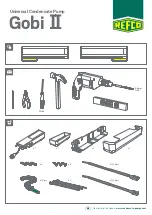
198 | GUIDELINES
MUL
TI V Ducted Indoor Unit Engineering Manual
Due to our policy of continuous product innovation, some specifications may change without notification.
©
LG Electronics U.S.A., Inc., Englewood Cliffs, NJ. All rights reserved. “LG” is a registered trademark of LG Corp.
Ensure the indoor unit, refrigerant piping, drain piping, and power wiring /
communication cables are properly supported with anchor bolts and clamp
hangers positioned at 3.3 to 4.9 foot intervals.
Maintenance
drain port
Upward
routing
not allowed
Pipe clamp
Indoor unit
Figure 73: Drain Piping Slope.
Insulation
Required
Insulation
Not Required
Properly Fitting Insulation
Figure 74: Properly Insulating the Drainage Piping.
Drain Piping
• Drain piping must have down slope (1/50 to 1/100).
• Any holes through the ceilings, walls, etc., must be large enough to
accommodate the drain piping and insulation.
• To prevent reversal flow, do not provide up and down slope.
• For High Static and Low Static Ducted Units, the outside diameter
of the drain connection is 1-1/4 to 1-1/8 inches (depending on
model).
• For Vertical / Horizontal Air Handling Units, use PVC with a 3/4
inch male pipe thread fitting for the condensate pan.
• For High Static and Low Static Ducted Units, the drain piping mate-
rial is polyvinyl chloride pipe (1 inch).
Drain Leak Test
A leak test must be performed 24 hours after the drainage system
has been installed.
Drain Pipe Insulation
To prevent condensate from forming on the drain piping, field-
supplied 5/16 inch thick polyethylene insulation must be properly
installed.
General Drain Piping Information
APPLICATION GUIDELINES
Common Indoor Unit Drainage System
It is usual work practice to connect individual
indoor unit drain pipes to one common indoor unit
drainage system.
The diameter of the common vertical drain pipe
must be as large as necessary. The diameter of
the horizontal pipe must be the same or larger
than the vertical drain pipe. To avoid property
damage in the event of the primary drain becom-
ing clogged, and to optimize drain system perfor-
mance, it may be prudent to install a secondary
drain line.
Design the drain system to plan for winter opera-
tion (condensate line may freeze up if condensate
does not properly drain away). Drain all gener-
ated condensate from the external condensate
pan to an appropriate area. Install a trap in the
condensate lines as near to the indoor unit coil as
possible. To prevent overflow, the outlet of each
trap must be positioned below its connection to
the condensate pan. All traps must be primed,
insulated, and leak tested.
Common horizontal drain pipe
1/50 to 1/100 Slop
e
27-1/2 in.
(Maximum pump
lift distance
[depends on indoor
unit type]).
Include trap
at the end.
45° to 60° Angle
Position the vent
down to prevent
debris from entering
the system
45° to 60° Angle
45° to 60° Angle
45° to 60° angle for protection against overflow
Common
vertical
drain pipe
Figure 75: Example of a Common Indoor Unit Drainage System.
• It is recommended that a dedicated drain pipe be installed for the air conditioning sys-
tem. If the indoor unit drainage system is shared with a rainwater drain, waste water,
or any other type of building drain system, back flow, leaks, ice may form, or noxious
odors may infiltrate the air conditioning system.
• Install a trap if the drain access to the outside faces an undesirable location (i.e.,
sewer), otherwise, noxious odors may infiltrate the air conditioning system.






































